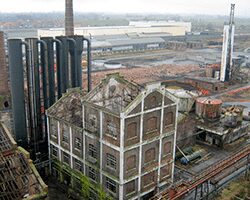
Public Waste Agency of Flanders (OVAM)
Industrial use, waste disposal, the increased use of chemicals and hazardous substances, and poor environmental management during past decades have left a legacy of contaminated sites across the WHO European Region. In the European Union alone, it is estimated that there are 2.8 million sites with potential contamination, and only some of these are formally registered and have their environmental and health consequences assessed. The potential health impacts of contaminated sites include increased prevalence of cancer, congenital anomalies and low birth weights in populations, as well as higher mortality rates.
For historical reasons, many contaminated sites are situated in or close to densely populated urban areas, increasing the potential impact of the contamination on nearby populations. Revitalizing and remediating these sites therefore not only addresses environment and health issues of contamination, but also provides opportunities for urban development.
“The legacy of contaminated sites is an ignored and underestimated health challenge, and rightfully established as one of the priority themes of the Ostrava Declaration on Environment and Health,” notes Sinaia Netanyahu, Programme Manager on Environment and Health Impact Assessment at the WHO European Centre for Environment and Health. “It is still unknown how many of these sites exist throughout the WHO European Region and we have just a rough understanding of the associated health impacts. Cleaning up these sites and making the land available for healthy and sustainable urban development is therefore a key challenge – especially for cities and regions with an intense industrial history.”
The redevelopment of contaminated sites entails various challenges and may cause continued or new environmental and health consequences if contamination risks are not properly managed and/or contaminated sites are not remediated. Summarizing the key messages of an expert consultation on redeveloping contaminated sites for new urban functions, a new WHO/Europe planning brief launched today presents:
- how health and environmental impacts can be considered during redevelopment;
- an overview of the project stages that need to be coordinated, from identification of a potential contaminated site to the redevelopment of the site; and
- useful planning practices for public authorities to support the effective, healthy and sustainable redevelopment of contaminated sites.
These key messages are of interest to national and local governments, decision-makers on environment and health, urban planners and practitioners, researchers, and civil society organizations working together for the remediation and redevelopment of contaminated sites across the Region, making our communities safer.














 English
English French
French Spanish
Spanish German
German Dutch
Dutch Italian
Italian Danish
Danish Portuguese
Portuguese Greek
Greek Russian
Russian Swedish
Swedish Bulgarian
Bulgarian Hungarian
Hungarian Catalan
Catalan Ukrainian
Ukrainian Polish
Polish Basque
Basque Chinese (Simplified)
Chinese (Simplified) Japanese
Japanese Hebrew
Hebrew Arabic
Arabic Swahili
Swahili Amharic
Amharic Irish
Irish Afrikaans
Afrikaans Albanian
Albanian Armenian
Armenian Azerbaijani
Azerbaijani Belarusian
Belarusian Bengali
Bengali Bosnian
Bosnian Cebuano
Cebuano Chichewa
Chichewa Chinese (Traditional)
Chinese (Traditional) Corsican
Corsican Croatian
Croatian Czech
Czech Esperanto
Esperanto Estonian
Estonian Filipino
Filipino Finnish
Finnish Frisian
Frisian Galician
Galician Georgian
Georgian Gujarati
Gujarati Haitian Creole
Haitian Creole Hausa
Hausa Hawaiian
Hawaiian Hindi
Hindi Hmong
Hmong Icelandic
Icelandic Igbo
Igbo Indonesian
Indonesian Javanese
Javanese Kannada
Kannada Kazakh
Kazakh Khmer
Khmer Korean
Korean Kurdish (Kurmanji)
Kurdish (Kurmanji) Kyrgyz
Kyrgyz Lao
Lao Latin
Latin Latvian
Latvian Lithuanian
Lithuanian Luxembourgish
Luxembourgish Macedonian
Macedonian Malagasy
Malagasy Malay
Malay Malayalam
Malayalam Maltese
Maltese Maori
Maori Marathi
Marathi Mongolian
Mongolian Myanmar (Burmese)
Myanmar (Burmese) Nepali
Nepali Norwegian
Norwegian Pashto
Pashto Persian
Persian Punjabi
Punjabi Romanian
Romanian Samoan
Samoan Scottish Gaelic
Scottish Gaelic Serbian
Serbian Sesotho
Sesotho Shona
Shona Sindhi
Sindhi Sinhala
Sinhala Slovak
Slovak Slovenian
Slovenian Somali
Somali Sundanese
Sundanese Tajik
Tajik Tamil
Tamil Telugu
Telugu Thai
Thai Turkish
Turkish Urdu
Urdu Uzbek
Uzbek Vietnamese
Vietnamese Welsh
Welsh Xhosa
Xhosa Yiddish
Yiddish Yoruba
Yoruba Zulu
Zulu